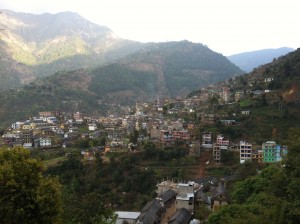Now that we are back the secondary research begins and we fill in the gaps on any particular subject by interviewing experts and reading academic publications with perhaps a bit more focus now than we did before we left. In a class on development I found an excerpt of a paper written by Nanda R. Shrestha, a Nepali man who now teaches in the U.S. He wrote a book in 1997 called In the Name of Development: A Reflection on Nepal. He briefly deals with “this new revolutionary movement which is commonly know as the ‘People’s War'” at the end of his book. Remember that the People’s War started in 1996, and was birthed in the districts of Rolpa and Rukum where later they established a parallel government. What I was unaware of was that USAID had implemented its largest development project in Nepal in these areas that had been in operation for 15 years when this book was published. It was a project that emphasized commercial farming and according to Shrestha resulted in a polarization of communities that eventually led to a violent insurrection. (p. 217)
This has, of course, opened up even more questions about Nepal, in particular these districts where the development project occurred. If such a model of development wasn’t successful before we had better make sure we are not regurgitating a slightly different version of the same model. It seems that the leadership of the Maoist forces have assimilated into the capital and have removed themselves quite a bit from “the people.” Is this an inevitable consequence of the system? Is there perhaps another way to ensure that the Nepalese people find a way to satisfy their basic needs and avoid approaches that have empirically proven to be flawed?



